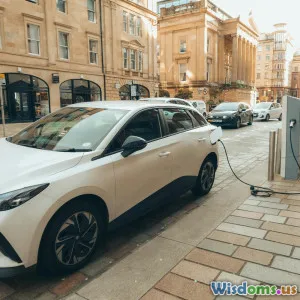
The Impact of EVs on Urban Mobility
6 min read Explore how electric vehicles (EVs) are transforming urban mobility and shaping the future of city transportation. (0 Reviews)
The Impact of EVs on Urban Mobility
Urban mobility is on the brink of a significant transformation, driven largely by the rise of electric vehicles (EVs). As cities around the world grapple with pollution, traffic congestion, and the need for sustainable solutions, EVs emerge as a crucial player in reshaping how we navigate our urban environments. This article explores the multifaceted impact of EVs on urban mobility, highlighting their potential benefits and ongoing challenges.
Understanding Urban Mobility
Urban mobility refers to the movement of people within urban areas. It encompasses various modes of transportation, including cars, buses, trains, bicycles, and walking. The efficiency and environmental impact of these systems are critical to the quality of life in cities. With the increasing population density in urban areas, there is a pressing need for sustainable and efficient transportation solutions.
The Rise of Electric Vehicles
The global shift towards electrification in the automotive industry has accelerated in recent years. Factors driving this trend include:
- Environmental Concerns: With climate change at the forefront of global issues, reducing greenhouse gas emissions has become imperative. EVs produce zero tailpipe emissions, significantly lowering urban air pollution levels.
- Technological Advancements: Improvements in battery technology have made EVs more affordable and practical, with increasing ranges and faster charging capabilities.
- Government Initiatives: Many governments are implementing incentives for EV adoption, such as tax credits, rebates, and infrastructure investments, helping to make electric cars more accessible.
Benefits of EVs for Urban Mobility
-
Reduced Emissions: The most significant benefit of EVs is their potential to reduce harmful emissions. Electric vehicles contribute to cleaner air in urban areas, improving public health and environmental quality.
-
Noise Pollution Reduction: EVs operate more quietly than traditional combustion engine vehicles, reducing noise pollution in urban environments, which can enhance the quality of life for residents.
-
Integration with Public Transport: EVs can complement public transportation systems. For instance, electric buses and taxis can reduce overall emissions while offering efficient travel options for urban dwellers.
-
Smart Transportation Systems: The development of smart grids and connected vehicles can enhance urban mobility. EVs can communicate with infrastructure to optimize traffic flow and reduce congestion, creating a more efficient urban transport network.
-
Cost Savings: Although the initial purchase price of an EV may be higher, the lower operating costs—such as maintenance and fuel—offer significant long-term savings for consumers and municipalities alike.
Challenges to Overcome
Despite the numerous advantages, the transition to EVs in urban mobility is not without challenges:
- Charging Infrastructure: The lack of adequate charging stations can hinder the widespread adoption of EVs. Cities need to invest in accessible and convenient charging solutions to meet growing demand.
- Range Anxiety: Many potential users are concerned about the driving range of EVs, especially in urban areas where long trips may be necessary. Improving battery technology and charging networks can help alleviate these concerns.
- Grid Capacity: The increased demand for electricity from EV charging can strain existing power grids. Urban planners must consider energy supply and demand when integrating EVs into the transportation ecosystem.
The Future of Urban Mobility with EVs
As cities continue to evolve, the integration of EVs into urban mobility systems will likely become a critical component of sustainable urban planning. Future developments may include:
- Autonomous EVs: The rise of autonomous electric vehicles can further revolutionize urban mobility by providing on-demand transportation solutions and reducing the need for personal car ownership.
- Mobility as a Service (MaaS): Integrating EVs into MaaS platforms allows seamless transitions between different modes of transport, enhancing user convenience and reducing reliance on personal vehicles.
- Increased Public Awareness: As the benefits of EVs become more widely recognized, public acceptance and adoption rates are expected to rise, leading to a more sustainable urban transport landscape.
Conclusion
The impact of electric vehicles on urban mobility is profound and multifaceted. While challenges remain, the potential benefits of cleaner air, reduced noise, and enhanced public transport integration make EVs an essential component of the future urban landscape. As cities adapt to the changing dynamics of transportation, embracing the electric vehicle revolution is vital for creating sustainable, efficient, and livable urban environments.
Rate the Post
User Reviews
Popular Posts



















